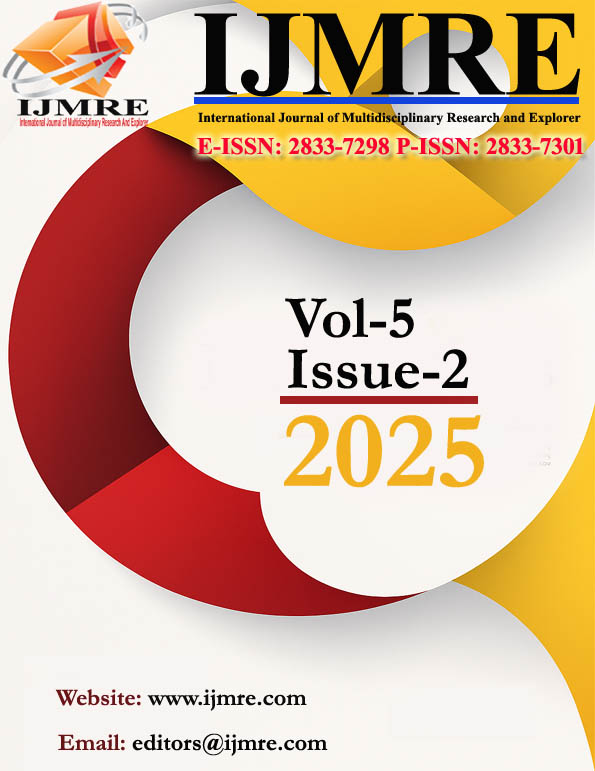Understanding North-East Woman’s Participation in State Governance- A Power Dynamics
DOI:
https://doi.org/10.70454/IJMRE.2025.05026Keywords:
Women, North-Eastern Region, Ethno-Political Movements, Political Participation, Power SharingAbstract
The northeastern states of India, popularly known as the Seven Sisters of India (Assam, Manipur, Meghalaya, Nagaland, Tripura, Mizoram, and Arunachal Pradesh), along with their brother state Sikkim, stand out with their unique geographical location and are home to several multi-ethnic communities. The region has witnessed several ethnic uprisings following the complexities of autonomy-related movements, the integration process, and the share in the natural resources. Needless to say, with the kind of societal structure prevailing in this region, women’s participation has been a major factor in ethnic movements in the past and even in the present. Indubitably, their participation in the societal and civil sphere of life is impressive. However, their involvement and presence in the larger political scenario, such as state institutions, are hardly felt.
The central inquiry of the paper is to analyse the role of women in ethno-political conflicts and parallelly examine the power-sharing dynamics of women in North-Eastern regions. Methodologically, this research involves a comprehensive study of documents from the Election Commission of India, focusing mainly on the percentage of women candidates in the northeast contesting in Lok Sabha elections from the time period of 2014 to 2024. Through the analysis of this data, the research will try to underscore the reason for the invisibility of women's role in larger power sharing where there is paradoxically huge participation of women in ethno-political issues.
References
[1] Banerjee, P.(2014). New conundrums for women in North-East India: Nagaland and Tripura, Economic & Political weekly, Vol. 49, no (43/44)pp. 57-65 URL: https://www.jstsor.org/stable/24480994
[2] Bhattacharya.(2010). Gender, Peace-making and the case of Northeast India, The Indian Journal of Political Science, Vol. 71, no (1) pp. 233-239 URL: https://www.jstor.org/stable/42748384
[3] Singh, A. Yangzes, T. Dr. Khosla, M.(2020). Status of women in North-East India, Research Journal of social science & Management, Vol. 10, pp. 47-54URL: www.theinternationaljournal.org.>
[4] Mishra, S.(2015). Women and Armed Conflict, The Indian Journal of Political Science, Vol. 76, no (4) URL: https://www.jstor.org/stable/10.2307/26575637
[5] Swami, I. (2021). Armed Conflict and Women: Experiences from North-East India, International Journal of all Research Education and Scientific Methods, Vol. 9, no (3) pp. 1649-1653 URL: www.ijaresm.com
[6] Banerjee,P. (2000). The Naga Women’s Interventions for Peace, Canadian women’s studies, Vol. 19, no (4) pp. 137-142 URL: https//core.ac.uk/download/pdf/276850363.pdF
[7] Samaddar. Ara Begum, A. (2014). New Fault line in conflict? Women’s Emergence as the subject of Peace in the North-East, Economic &Political Weekly, Vol. 49, no (43/44) pp. 74-83 URL: https://www.jstor.org/stable /24480996
[8] Sharma, A. (2020). Ethnic conflict in North East India, Journal of critical reviews, Vol. 7, no (04) pp. 2174-2176 URL:https://www.jcreview.com
[9] Krishnan, M.(2023). India: Manipur women rise against ethnic violence, Deccan World, URL: https://www.dw.com/en/india-manipur-women-rise-against-ethnic-violence/a-66177572
[10] Chakraborty. (2023). Women in India’s Northeast are frontrunners in every sphere, URL: https://www.indiablooms.com/life-details/L/7017/women-in-india-s-northeast-are-frontrunners-in-every-sphere.html
[11] Borah, P. (2015). Political Participation of Women in North-East India with Special Reference to Assam after Independence. International Journal of Interdisciplinary Research in Science Society and Culture, 1(2), 123-129.
[12] Ojha, R. (2014). Women in Electoral Politics in Nagaland, India. International Research Journal of Social Sciences, 3(11), 47-50.
[13] Ahmed, H. (2020). Gender Divide in the Political Representation in North East India. Journal of Critical Reviews, 7(13).
[13] Data collection - https://eci.gov.in/
[14] http://neta.com/
Downloads
Published
Issue
Section
License
Copyright (c) 2025 Srikant Mahali, Reshmi Biswas (Author)

This work is licensed under a Creative Commons Attribution 4.0 International License.
This is an Open Access article distributed under the term's of the Creative Common Attribution 4.0 International License permitting all use, distribution, and reproduction in any medium, provided the work is properly cited.







